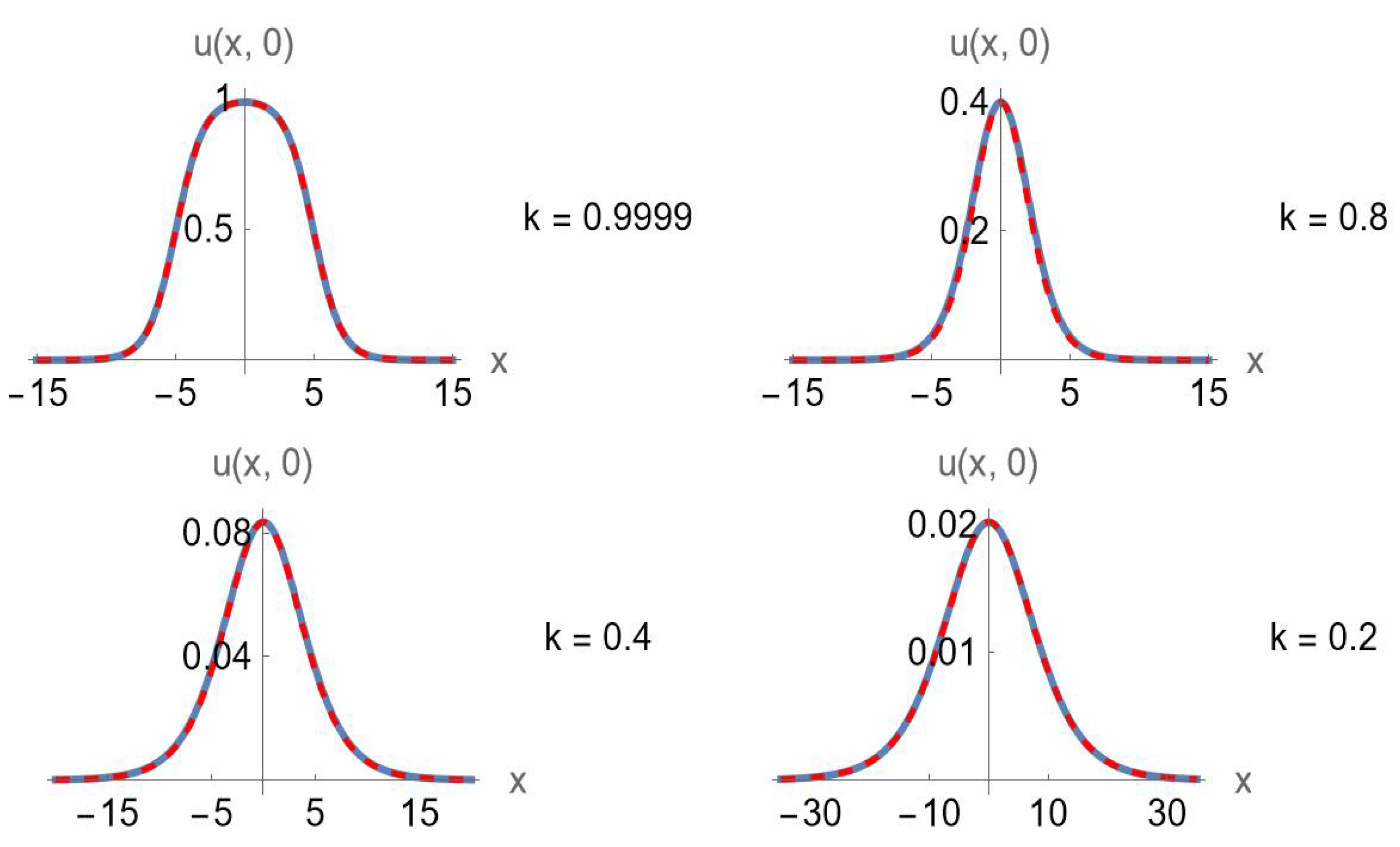Using Symmetries to Investigate the Complete Integrability, Solitary Wave Solutions and Solitons of the Gardner Equation
Abstract
1. Introduction
2. The Gardner Equation
3. Painlevé Analysis
- Step 1: Compute the leading order term. To determine and , substitute into (1). Balance the minimal power terms in g, namely, and , to get . Next, require that the leading terms (in vanish, yielding
- Step 2: Compute the resonances. In this step, one determines which functions in (5) will remain arbitrary. That happens at specific values of k, called resonances, denoted by r. To find the resonances, substitute , with and given in (6) or (7) into (1), and equate the coefficients of the dominant terms (in ) that are linear in to get the characteristic equationSince the resonances are , and Resonance corresponds to the arbitrariness of g.
- Step 3: Check the compatibility conditions. To do so, substituteinto (1) and verify that and can be unambiguously determined. Verify also that and are indeed arbitrary functions, meaning that no compatibility conditions arise. For (1), one readily determines the real functions,when (and complex expressions when ). At resonance , the compatibility condition (arising as the coefficient of ),is identically satisfied upon substitution of (6) and (10). Likewise, a long but straightforward computation shows that the compatibility condition at (appearing at order ),is identically satisfied upon substitution of (6), (10), and (11).
4. Scaling Symmetry
5. Conservation Laws
- Step 1: Construct a candidate density of rank 4 as follows: Make a list of all monomials in u and of rank 4 or less, i.e., , , , , . For the construction of candidate densities, the constant terms can be removed. Then, for each monomial in that list, apply the correct number of x-derivatives so that the resulting term has exactly rank 4. The terms in the first sublist need no derivatives. Those in the second sublist need a single derivative. The next set of terms need two derivatives, etc. For example, for the first element in the third sublist, Obviously, if we carry out partial integration, the highest derivative term only differs from by the x-derivative of and therefore can be ignored. Likewise, terms like , , , and can be neglected because they are x-derivatives of single-term monomials (, , etc.). There is no need to put terms like , in the density because they can be moved to the flux.
- Step 2: Compute the undetermined coefficients. Using (23), first computewhere is the identity operator. Replace and from (1) to getNext, find the constants and so that matches for some flux J (to be computed in Step 3 below). Mathematically, this means that E must be exact. The Euler operator (variational derivative),allows one to test exactness [21,22,23,42], where K is the order of the expression the Euler operator is applied to. Therefore, for E in (30). Consequently, (31) will terminate after five terms. E will be exact if on the jet space (treating , etc., and also all monomials in such variables as independent). The computation of the terms in (31) involves nothing more than partial differentiations followed by (total) differentiations with respect to x. Of a total of 30 terms (not listed) generated, many terms are canceled, and one is left withwhich must vanish identically, yielding the linear system and with solution . Substitute these constants into (28) to obtainthe same expression as in (27). If one were only interested in the density, the computation would finish here. To continue with the computation of the flux (in the next step), substitute the constants into (30), yielding
- Step 3: Compute the flux. Since , to get one must integrate E with respect to x and reverse the sign. There is a tool from differential geometry, called the homotopy operator [43] p. 372, to carry out integration by parts on the jet space. As will be shown below, application of the homotopy operator reduces the integration on the jet space to a standard one-dimensional integration with respect to an auxiliary variable which will be denoted by .
6. Generalized Symmetries
- Step 1: Construct a candidate symmetry of rank 6 as follows: List all monomials in u and of rank 6 or less, i.e., , , , , , , without the constant terms .
- Step 2: Find the undetermined coefficients. Compute and use (4) to remove , etc. This produces an expression with 176 terms (not listed). Next, compute (44) usingand G from (48), yielding 193 terms (not listed). Then, , which has 138 terms, must vanish identically on the jet space, yielding a linear system of 20 equations for the nine nonzero coefficients , through , and :For brevity, we have shown only a couple of the shortest equations (coming from and , respectively) and two of the longest equations (coming from and , respectively). The 18 coefficients through , through , and through are all zero. Solving the system yieldsSet and substitute (51) into (48) to obtainwhich matches in (47).
7. Recursion Operator
- Step 1: Compute the candidate recursion operator. Using (20), list all monomials in , and of rank 2 or less, i.e., , , , where the trivial terms and have been removed. Apply the correct number of x-derivatives to the monomials in each of the two sublists to assure that each term has rank 2. No action is needed on the first sublist. The elements in the second sublist need a single derivative, yielding . After stripping off numerical factors and removing duplicates, linearly combine the resulting monomials with constant coefficients to obtain a candidate local operatorUsing symmetry and densities and (all of low rank), compute and . Then, with terms of type (63), make the candidate non-local operatorso that each term has rank 2. Add both pieces to get the candidate recursion operator
- Step 2: Compute the undetermined coefficients. Separately compute all the pieces in (57), beginning withwhich can also be computed using (60). With F given in (49), insertinto (67), expand, and simplify. This yields an expression of 27 terms (not listed). Some of the terms have and ; others involve , , , , and . Next, using (58), computeWith (66) and (69), then computeusing, for example,to consistently move the operator from the left to the right. To be able to match the integral terms in (67) which are mentioned below (68), repeated integration by parts is needed [55]. For example,converts the integral into by moving the operator under the operator from the right to the left. After integration by parts, has 58 terms (not listed). Next, computeTo move the operator to the right, use, for example,and similar formulas (expressed in a more general form in [55]). The expanded expression for has 73 terms. Substitute the simplified expressions for (67), (70), and (73) into (57) and require that the resulting expression (which has 36 terms) vanishes identically, i.e., all monomials in , , ⋯, should be treated as independent. This yields and a linear system,involving the remaining nonzero constants. Solve the system to get
8. Lax Pair
- Step 1: Construct a candidate for and . Since the KdV and mKdV equations are special cases of (1), it makes sense to search for of rank 2 and of rank 3. To construct , list all monomials in , and of rank 2 or less, i.e., , , , , , , , where the trivial terms and have been removed. As explained in Section 7, apply to the elements in the second sublist and, as in (62), propagate to the right, yielding . After removing duplicates, linearly combine the monomials from both sublists with constant coefficients to get a candidate for :where the coefficient of has been set to one (for normalization).
- Step 2: Compute the undetermined coefficients. First, computewhich, after substituting F from (49) to replace and , yields 14 terms. Next, computewhich upon expansion has 125 terms, andwhich after expansion has 126 terms.
9. Bilinear Form
- Step 1: Construct a bilinear form as follows: first, integrate (100) with respect to x,setting the integration “constant” equal to zero. As with the mKdV equation [5], substitute the Hirota transformationinto (101). Then, divide by and regroup the terms, yieldingNext, set the factors multiplying and separately equal to zero, to obtainBased on the scaling symmetry of (1) with weights (20) and the structure of the bilinear form of the mKdV equation [5], recast the above equations in bilinear form,with undetermined coefficients , and . Notice that with , all terms in (104) and (106) have weights of three, whereas the terms in (105) and (107) have weights of two.
- Step 2: Compute the undetermined coefficients. Equate (106) and (110) and treat all monomials in f and g and their derivatives as independent to get and Perform the same with (107) and (111) to get . Finally, substitute the constants into (106) and (107) and clear common factors to get a bilinear representation of (100):which, in light of (102), will only lead to real solutions for the focusing Gardner equation .
10. Gardner Transformation
- Step 1: Construct a candidate for the Gardner transformation. Make the list , of monomials in v and of rank 2 or less. By differentiating its elements, replace the second sublist by . Linearly combine the resulting elements with undetermined coefficients,to generate a candidate for the Gardner transformation.
- Step 2: Compute the undetermined coefficients. Substitute (124) into (122) and, using (121), replace and . The resulting expression must vanish on the jet space, leading to and half a dozen more complicated equations. For , (124) would become an algebraic transformation. Hence, and, after simplification of the more complicated equations, one is left with the following nonlinear systemSubstitute the solution, , , , and , into (124) to get (120).
11. The Korteweg–de Vries Equation
12. The Modified Korteweg–de Vries Equation
- Case I: The focusing mKdV equation ().The mKdV Equation (114) has solutions involving a cosh-function,with , where the boundary value , wave number k, and phase are arbitrary constants. To prevent blow-up in finite time we will only consider the plus sign in (137). The solution satisfying has been computed with Hirota’s method in [73], where only the case was considered. Solution (137) is also valid for with a caveat (see below). For the solution reduces to the well-known -solution,where the ± sign is due to the invariance of (114) under the discrete symmetry .
- Case II: The defocusing mKdV equation ().
13. Solitary Wave and Periodic Solutions
- Case I: The focusing Gardner equation .The most well-known solutions arewith , andwith . Both solutions for the minus sign (in front of the square root) are shown in Figure 2. Observe that as the value of m gets closer to 1, the -function starts taking the shape of a -profile.Of course, (145) also follows directly from (138) upon application of the transformation (113). Using (137) in the same way yieldswith and where is arbitrary. Setting yieldswith , where denotes the speed of the wave and is the effective width of the solitary wave. This special solution is frequently used in the literature [35,66,76,77,78,79] and could also be computed via a Darboux transformation (see, e.g., [78]). For , (148) is valid for all values of V, and since the wave is travelling to the right.
- Case II: The defocusing Gardner equation ().The simplest exact solutions arewith , andwith . In each of these solutions, is an arbitrary constant phase. The shock wave solution (149) and periodic solution (150) can be found in, e.g., ref. [74]. Both solutions for the minus sign (in front of the square root) are shown in Figure 3. As the value of m draws closer to 1, the -function starts taking the shape of a -profile.With respect to (148) where , note that when , the argument of the square root, , will be zero when . Thus, (148) is only valid when the speed is below that critical value (). Thus, when dealing with the defocusing Gardner equation, if , there is no solution of type (148). Turning the argument around, solutions for (148) of large amplitude (which is proportional to ) or fast traveling waves (since ) can only occur if is relatively small in comparison with . For example, for , one must require that .
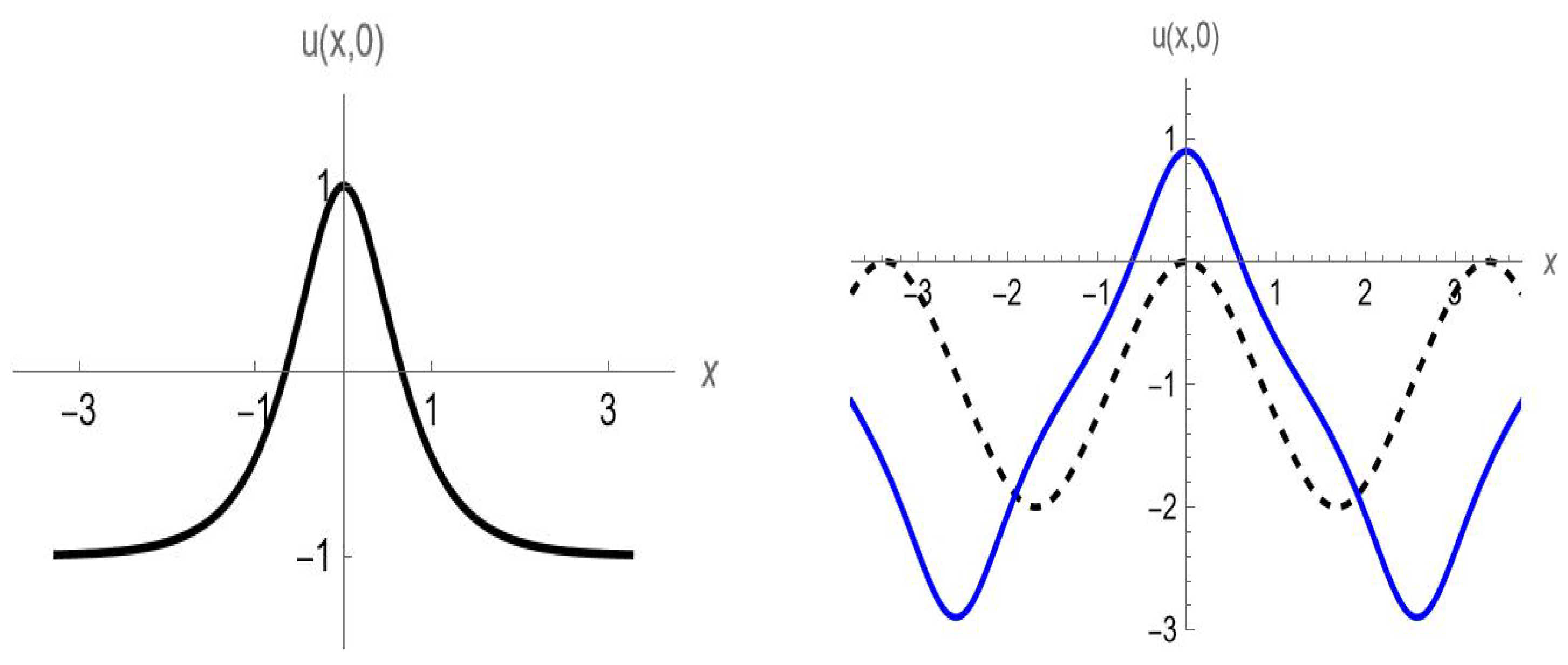
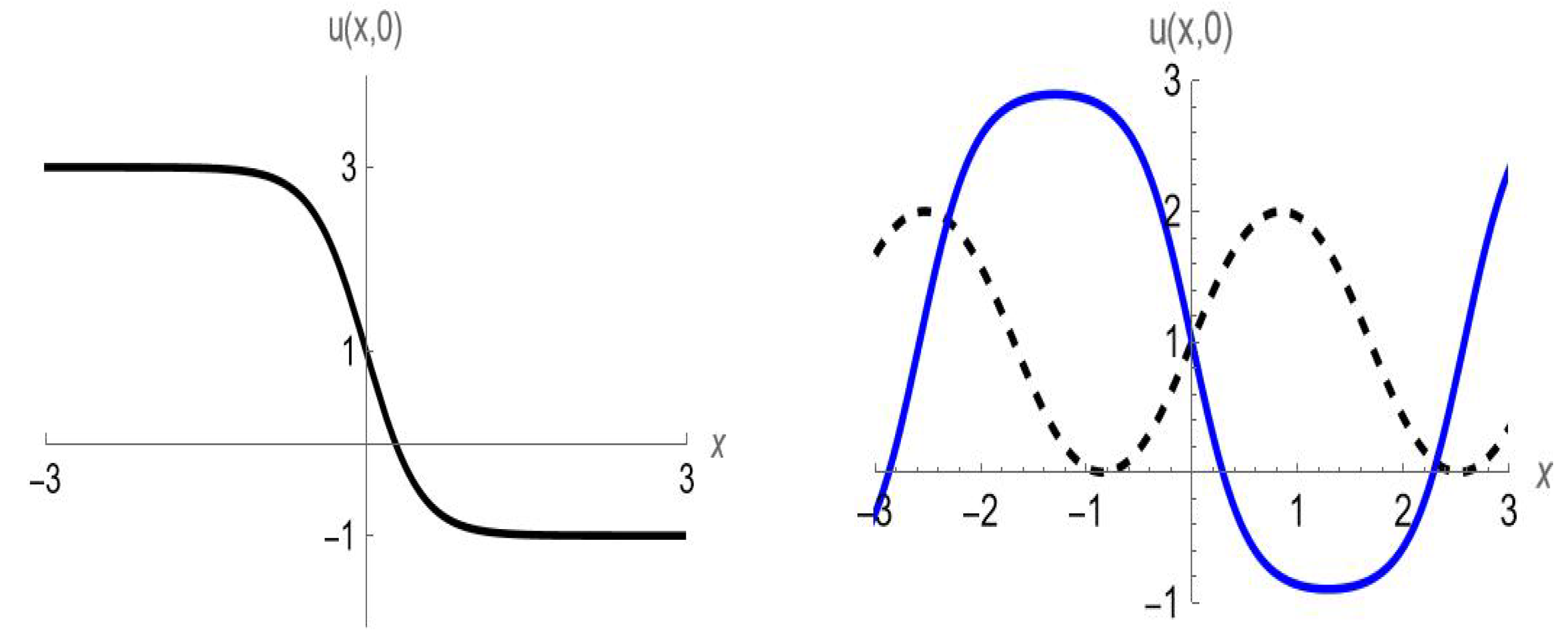
14. Soliton Solutions
- Case I: The focusing Gardner equation ().Using (113), solutions of the focusing version of (1) are given bywhere is any soliton solution of the focusing mKdV equation and and . For example, the two-soliton solution of (1) readswhere and . The elastic scattering of two solitons for the focusing Gardner equation is shown in Figure 6 and Figure 7, which have 2D and 3D graphs of (155) for with , , and .
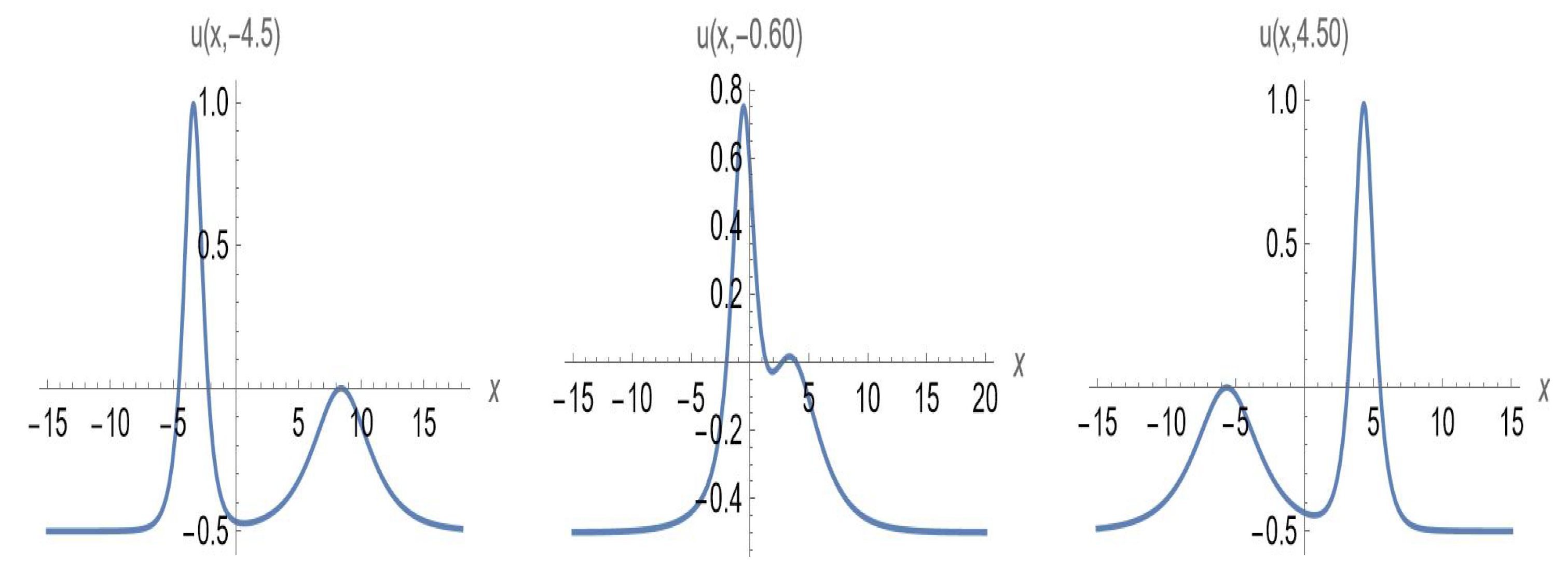
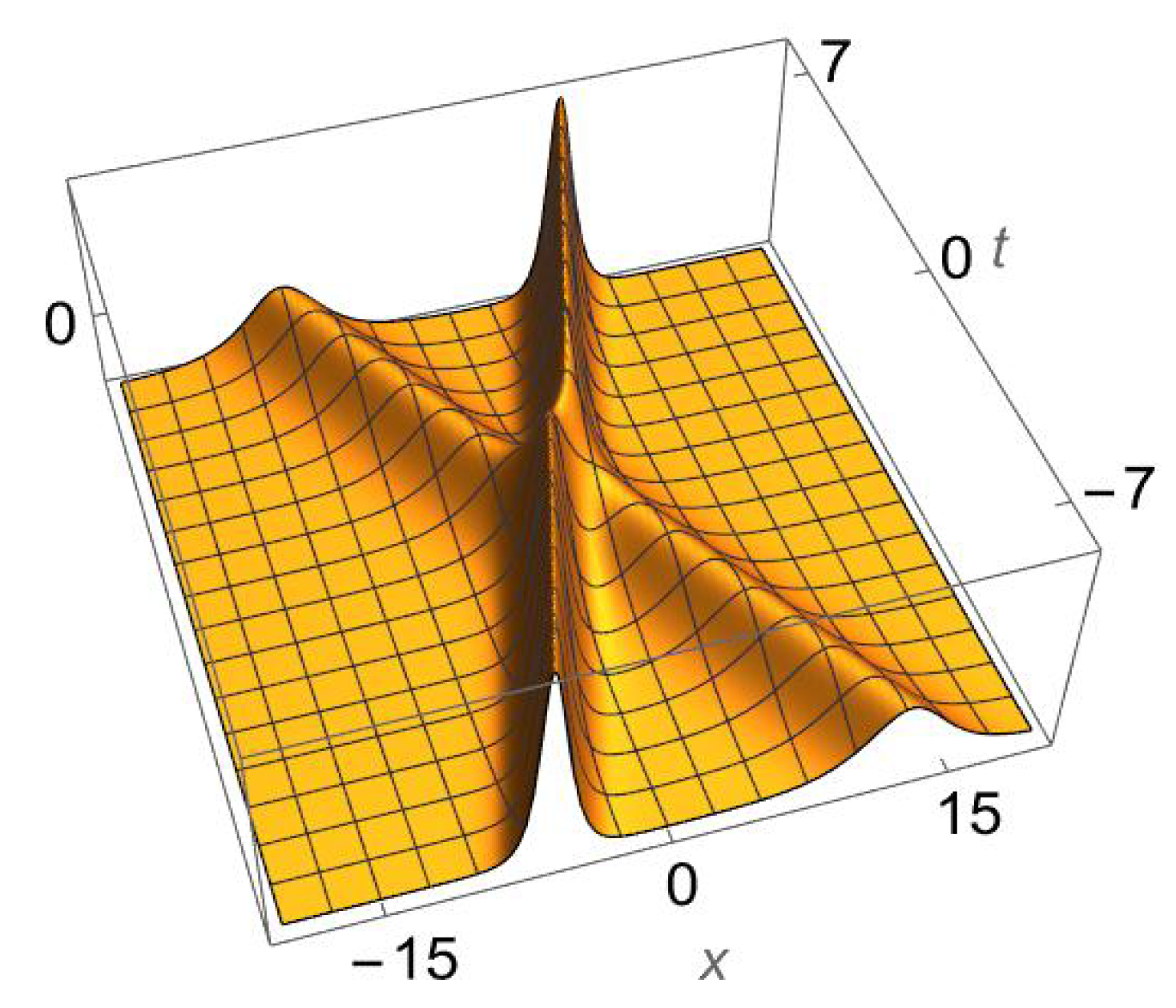
- Case II: The defocusing Gardner equation ().
15. Symbolic Software
16. Conclusions and Future Work
Author Contributions
Funding
Data Availability Statement
Acknowledgments
Conflicts of Interest
References
- Ablowitz, M.J.; Clarkson, P.A. Solitons, Nonlinear Evolution Equations and Inverse Scattering; London Mathematical Society Lecture Note Series; Cambridge University Press: Cambridge, UK, 1991; Volume 149. [Google Scholar]
- Ablowitz, M.J.; Segur, H. Solitons and The Inverse Scattering. In SIAM Studies in Applied Mathematics; SIAM: Philadelphia, PA, USA, 1981; Volume 4. [Google Scholar]
- Remoissenet, M. Waves Called Solitons: Concepts and Experiments, 3rd ed.; Springer: Berlin/Heidelberg, Germany, 1999. [Google Scholar]
- Zakharov, V.E. (Ed.) What is Integrability? Springer Series in Nonlinear Dynamics; Springer: Berlin/Heidelberg, Germany, 1991. [Google Scholar]
- Hereman, W.; Göktaş, Ü. Symbolic computation of solitary wave solutions and solitons through homogenization of degree. In Nonlinear and Modern Mathematical Physics, Proceedings of the 6th International Workshop on Nonlinear and Modern Mathematical Physics (NMMP2022), Tallahassee, FL, USA, 17–19 June 2022; Springer Proceedings in Mathematics & Statistics; Manukure, S., Ma, W.-X., Eds.; Springer: New York, NY, USA, 2024; Chapter 4; pp. 101–164. [Google Scholar]
- Hirota, R. The Direct Method in Soliton Theory. In Cambridge Tracts in Mathematics; Cambridge University Press: Cambridge, UK, 2004; Volume 155. [Google Scholar]
- Baldwin, D.; Hereman, W. Symbolic software for the Painlevé test of nonlinear ordinary and partial differential equations. J. Nonl. Math. Phys. 2006, 13, 90–110. [Google Scholar] [CrossRef]
- Baldwin, D.; Hereman, W. PainleveTest.m: A Mathematica Package for the Painlevé Test of Systems of Nonlinear Ordinary and Partial Differential Equations; Department of Applied Mathematics and Statistics, Colorado School of Mines: Golden, CO, USA, 2001. [Google Scholar]
- Göktaş, Ü.; Hereman, W. Symbolic computation of conserved densities for systems of nonlinear evolution equations. J. Symb. Comp. 1997, 24, 591–621. [Google Scholar] [CrossRef]
- Göktaş, Ü.; Hereman, W. Algorithmic computation of higher-order symmetries for nonlinear evolution and lattice equations. Adv. Comput. Math. 1999, 11, 55–80. [Google Scholar] [CrossRef]
- Kirane, M.; Stalin, S.; Arun, R.; Lakshmanan, M. Soliton molecules in Fermi–Pasta–Ulam–Tsingou lattice: Gardner equation approach. Chaos Solitons Fractals 2024, 178, 114393. [Google Scholar] [CrossRef]
- Mucalica, A.; Pelinovsky, D.E. Dark breathers on a snoidal wave background in the defocusing mKdV equation. Lett. Math. Phys. 2024, 14, 100. [Google Scholar] [CrossRef]
- Slyunyaev, A.V. Dynamics of localized waves with large amplitude in a weakly dispersive medium with a quadratic and positive cubic nonlinearity. J. Exper. Theor. Phys. 2001, 92, 529–534. [Google Scholar] [CrossRef]
- Slyunyaev, A.V.; Pelinovsky, E.N. Role of multiple soliton interactions in the generation of rogue waves: The modified Korteweg–de Vries framework. Phys. Rev. Lett. 2016, 117, 214501. [Google Scholar] [CrossRef]
- Zhang, G.; Yan, Z. Focusing and defocusing mKdV equations with nonzero boundary conditions: Inverse scattering transforms and soliton interactions. Phys. D 2014, 410, 132521. [Google Scholar] [CrossRef]
- Baldwin, D.; Hereman, W. PDERecursionOperator.m: A Mathematica Package for the Symbolic Computation of Recursion Operators for Nonlinear Partial Differential Equations; Department of Applied Mathematics and Statistics, Colorado School of Mines: Golden, CO, USA, 2003. [Google Scholar]
- Göktaş, Ü.; Hereman, W. InvariantsSymmetries.m: A Mathematica Integrability Package for the Computation of Invariants and Symmetries of Nonlinear Systems of Partial Differential Equations and Differential-Difference Equations; Department of Applied Mathematics and Statistics, Colorado School of Mines: Golden, CO, USA, 1997. [Google Scholar]
- Poole, D.; Hereman, W. ConservationLawsMD.m: A Mathematica Package for the Symbolic Computation of Conservation Laws of Polynomial Systems of Nonlinear PDEs in Multiple Space Dimensions; Department of Applied Mathematics and Statistics, Colorado School of Mines: Golden, CO, USA, 2009. [Google Scholar]
- Hereman, W.; Göktaş, Ü. Integrability Tests for Nonlinear Evolution Equations. In Computer Algebra Systems: A Practical Guide; Wester, M., Ed.; Wiley: New York, NY, USA, 1999; Chapter 12; pp. 211–232. [Google Scholar]
- Hereman, W.; Göktaş, Ü.; Colagrosso, M.; Miller, A. Algorithmic integrability tests for nonlinear differential and lattice equations. Comp. Phys. Commun. 1998, 115, 428–446. [Google Scholar] [CrossRef][Green Version]
- Hereman, W.; Colagrosso, M.; Sayers, R.; Ringler, A.; Deconinck, B.; Nivala, M.; Hickman, M.S. Continuous and discrete homotopy operators with applications in integrability testing. In Differential Equations with Symbolic Computation; Wang, D., Zheng, Z., Eds.; Birkhäuser Verlag: Basel, Switzerland, 2005; Chapter 15; pp. 255–290. [Google Scholar]
- Hereman, W.; Adams, P.J.; Eklund, H.L.; Hickman, M.S.; Herbst, B.M. Direct methods and symbolic software for conservation laws of nonlinear equations. In Advances in Nonlinear Waves and Symbolic Computation; Yan, Z., Ed.; Nova Science Publishers: New York, NY, USA, 2009; Chapter 2; pp. 19–79. [Google Scholar]
- Poole, D.; Hereman, W. Symbolic computation of conservation laws for nonlinear partial differential equations in multiple space dimensions. J. Symb. Comp. 2011, 46, 1355–1377. [Google Scholar] [CrossRef]
- Göktaş, Ü.; Hereman, W. PDESolitonSolutions.m: A Mathematica Package for the Symbolic Computation of Solitary Wave and Soliton Solutions of Polynomial Nonlinear PDEs Using a Simplified Version of Hirota’s Method; Department of Applied Mathematics and Statistics, Colorado School of Mines: Golden, CO, USA, 2023. [Google Scholar]
- Baldwin, D.; Hereman, W. PDESpecialSolutions.m: A Mathematica Package for the Symbolic Computation of Exact Solutions Expressible in Hyperbolic and Elliptic Functions for Systems of Nonlinear Partial Differential Equations; Department of Applied Mathematics and Statistics, Colorado School of Mines: Golden, CO, USA, 2003. [Google Scholar]
- Baldwin, D.; Göktaş, Ü.; Hereman, W.; Hong, L.; Martino, R.S.; Miller, J.C. Symbolic computation of exact solutions expressible in hyperbolic and elliptic functions for nonlinear PDEs. J. Sym. Comput. 2004, 37, 669–705. [Google Scholar] [CrossRef]
- Gardner, C.S.; Greene, J.M.; Kruskal, M.D.; Miura, R.M. Korteweg-de Vries equation and generalizations. VI. Methods for exact solution. Commun. Pure Appl. Math. 1974, 27, 97–133. [Google Scholar] [CrossRef]
- Korteweg, D.J.; de Vries, G. XLI. On the change of form of long waves advancing in a rectangular canal, and on a new type of long stationary waves. Philos. Mag. 1895, 39, 422–443. [Google Scholar] [CrossRef]
- Hereman, W. Shallow water waves and solitary waves. In Encyclopedia of Complexity and Systems Science; Meyers, R.A., Ed.; Springer: Berlin/Heidelberg, Germany, 2009; Volume 11, pp. 8112–8125. [Google Scholar]
- Drazin, P.G.; Johnson, R.S. Solitons: An Introduction. In Cambridge Texts in Applied Mathematics; Cambridge University Press: Cambridge, UK, 1989. [Google Scholar]
- Miura, R. Korteweg-de Vries equation and generalizations. I. A remarkable explicit nonlinear transformation. J. Math. Phys. 1968, 9, 1202–1204. [Google Scholar] [CrossRef]
- Miura, R.M.; Gardner, C.S.; Kruskal, M.D. Korteweg-de Vries equation and generalizations. II. Existence of conservation laws and constants of motion. J. Math. Phys. 1968, 9, 1204–1209. [Google Scholar] [CrossRef]
- Kakutani, T.; Yamasaki, N. Solitary waves on a two-Layer fluid. J. Phys. Soc. Jpn. 1978, 45, 674–679. [Google Scholar] [CrossRef]
- Zhang, D.-J.; Zhao, S.-L.; Sun, Y.Y.; Zhou, J. Solutions to the modified Korteweg–de Vries equation. Rev. Math. Phys. 2014, 26, 1430006. [Google Scholar] [CrossRef]
- Grimshaw, R. Nonlinear wave equations for oceanic internal solitary waves. Stud. Appl. Math. 2015, 136, 214–237. [Google Scholar] [CrossRef]
- Miles, J.W. On internal solitary waves. Tellus A Dyn. Meteor. Ocean. 1979, 31, 456–462. [Google Scholar] [CrossRef]
- Kamchatnov, A.M.; Kuo, Y.-H.; Lin, T.-C.; Horng, T.-L.; Gou, S.-C.; Clift, R.; El, G.A.; Grimshaw, R.H.J. Undular bore theory for the Gardner equation. Phys. Rev. E 2012, 86, 036605. [Google Scholar] [CrossRef]
- Olivier, C.P.; Verheest, F. Overtaking collisions of double layers and solitons: Tripolar structures and dynamical polarity switches. Phys. Plasmas 2020, 27, 062303. [Google Scholar] [CrossRef]
- Olivier, C.P.; Verheest, F.; Maharaj, S.K. A small-amplitude study of solitons near critical plasma compositions. J. Plasma Phys. 2016, 82, 905820605. [Google Scholar] [CrossRef]
- Torvén, S. Modified Korteweg-de Vries equation for propagating double layers in plasmas. Phys. Rev. Lett. 1981, 47, 1053–1056. [Google Scholar] [CrossRef]
- Verheest, F.; Hereman, W.; Olivier, C.P. On the Gardner equation for nonlinear waves in multispecies plasmas. J. Plasma Phys. 2024. in preparation. [Google Scholar] [CrossRef]
- Hereman, W.; Deconinck, B.; Poole, L.D. Continuous and discrete homotopy operators: A theoretical approach made concrete. Math. Comput. Simul. 2007, 74, 352–360. [Google Scholar] [CrossRef]
- Olver, P.J. Applications of Lie Groups to Differential Equations, 2nd ed.; Graduate Texts in Mathematics;, Springer: New York, NY, USA, 1993; Volume 107. [Google Scholar]
- Poole, D.; Hereman, W. The homotopy operator method for symbolic integration by parts and inversion of divergences with applications. Appl. Anal. 2010, 89, 433–455. [Google Scholar] [CrossRef]
- Cohen, D.; Hairer, E.; Lubich, C. Conservation of energy, momentum and actions in numerical discretizations of non-linear wave equations. Numer. Math. 2008, 110, 113–143. [Google Scholar] [CrossRef]
- Frasca-Caccia, G.; Hydon, P.E. Locally conservative finite difference schemes for the modified KdV equation. J. Comput. Dyn. 2019, 6, 307–323. [Google Scholar] [CrossRef]
- Sanz-Serna, J.M. An explicit finite-difference scheme with exact conservation properties. J. Comput. Phys. 1982, 47, 199–210. [Google Scholar] [CrossRef]
- Ascher, U.M.; McLachlan, R.I. On symplectic and multisymplectic schemes for the KdV equation. J. Sci. Comput. 2005, 25, 83–104. [Google Scholar]
- Bridges, T.J.; Reich, S. Numerical methods for Hamiltonian PDEs. J. Phys. A Math. Gen. 2006, 39, 5287–5320. [Google Scholar] [CrossRef]
- Quispel, R.; McLachlan, R. Preface to special issue on ‘Geometric Numerical Integration of Differential Equations’. J. Phys. A Math. Gen. 2006, 39, E01–E03. [Google Scholar]
- Hairer, E.; Lubich, C.; Wanner, G. Geometric Numerical Integration: Structure-Preserving Algorithms for Ordinary Differential Equations, 2nd ed.; Springer Series in Computational Mathematics; Springer: Berlin/Heidelberg, Germany, 2006; Volume 31. [Google Scholar]
- LeVeque, R.J. Numerical Methods for Conservation Laws, 2nd ed.; Lectures in Mathematics; Birkhäuser: Basel, Switzerland, 1992; Volume 214. [Google Scholar]
- Sanz-Serna, J.M.; Calvo, M.P. Numerical Hamiltonian Problems. Applied Mathematics and Mathematical Computation; Courier Dover Publications: Mineola, NY, USA, 2018. [Google Scholar]
- Olver, P. Evolution equations possessing infinitely many symmetries. J. Math. Phys. 1977, 18, 1212–1215. [Google Scholar] [CrossRef]
- Baldwin, D.; Hereman, W. A symbolic algorithm for computing recursion operators of nonlinear partial differential equations. Int. J. Computer Math. 2010, 97, 1094–1119. [Google Scholar] [CrossRef]
- Fuchssteiner, B.; Oevel, W.; Wiwianka, W. Computer-algebra methods for investigation of hereditary operators of higher order soliton equations. Comput. Phys. Commun. 1987, 44, 47–55. [Google Scholar] [CrossRef]
- Wang, J.P. Symmetries and Conservation Laws of Evolution Equations. Ph.D. Thesis, Thomas Stieltjes Institute for Mathematics, Free University of Amsterdam, Amsterdam, The Netherlands, 1998. [Google Scholar]
- Wang, J.P. A list of (1+1) dimensional integrable equations and their properties. J. Nonl. Math. Phys. 2002, 9, 213–233. [Google Scholar] [CrossRef]
- Sanders, J.A.; Wang, J.P. Integrable systems and their recursion operators. Nonlinear Anal. 2001, 47, 5213–5240. [Google Scholar] [CrossRef]
- Sanders, J.A.; Wang, J.P. On recursion operators. Phys. D 2001, 149, 1–10. [Google Scholar] [CrossRef]
- Baldwin, D.; Hereman, W.; Sayers, J. Symbolic algorithms for the Painlevé test, special solutions, and recursion operators for nonlinear PDEs. In Group Theory and Numerical Analysis; Winternitz, P., Gomez-Ullate, D., Iserles, A., Levi, D., Olver, P.J., Quispel, R., Tempesta, P., Eds.; CRM Proceedings and Lecture Notes; AMS: Providence, RI, USA, 2005; Volume 39, pp. 17–32. [Google Scholar]
- Bilge, A.H. On the equivalence of linearization and formal symmetries as integrability tests for evolution equations. J. Phys. A: Math. Gen. 1973, 26, 7511–7519. [Google Scholar] [CrossRef]
- Hickman, M.; Hereman, W.; Larue, J.; Göktaş, Ü. Scaling invariant Lax pairs of nonlinear evolution equations. Appl. Anal. 2012, 91, 381–402. [Google Scholar] [CrossRef]
- Lax, P.D. Integrals of nonlinear equations of evolution and solitary waves. Commun. Pure Appl. Math. 1968, 21, 467–490. [Google Scholar] [CrossRef]
- Larue, J. Symbolic Verification of Operator and Matrix Lax Pairs for Some Completely Integrable Nonlinear Partial Differential Equations. Master’s Thesis, Department of Mathematical and Computer Sciences, Colorado School of Mines, Golden, CO, USA, 2011. [Google Scholar]
- Alejo, M.A.; Muñoz, C.; Vega, L. The Gardner equation and the L2-stability of the N-soliton solution of the Korteweg–de Vries equation. Trans. Amer. Math. Soc. 2012, 365, 195–212. [Google Scholar] [CrossRef][Green Version]
- Miura, M.R. The Korteweg de Vries equation: A survey of results. SIAM Rev. 1976, 18, 412–459. [Google Scholar] [CrossRef]
- Muñoz, C. The Gardner equation and the stability of multi-kink solutions of the mKdV equation. Discrete Cont. Dyn. Sys. 2016, 36, 3811–3843. [Google Scholar] [CrossRef][Green Version]
- Kruskal, M.D.; Miura, R.M.; Gardner, C.S.; Zabusky, N.J. Korteweg-de Vries equation and generalizations. V. Uniqueness and nonexistence of polynomial conservation laws. J. Math. Phys. 1970, 11, 952–960. [Google Scholar] [CrossRef]
- Wadati, M. The exact solution of the modified Korteweg-de Vries equation. J. Phys. Soc. Jpn. 1972, 32, 1681. [Google Scholar] [CrossRef]
- Wadati, M. The modified Korteweg-de Vries equation. J. Phys. Soc. Jpn. 1973, 34, 1289–1296. [Google Scholar] [CrossRef]
- Burde, G.I. Lax pairs for the modified KdV equation. Axioms 2024, 13, 121. [Google Scholar] [CrossRef]
- Ablowitz, M.J.; Satsuma, J. Solitons and rational solutions of nonlinear evolution equations. J. Math. Phys. 1978, 19, 2180–2186. [Google Scholar] [CrossRef]
- Ono, H. Solitons on a background and a shock wave. J. Phys. Soc. Jpn. 1976, 40, 1487–1497. [Google Scholar] [CrossRef]
- Pelinovsky, E.; Talipova, T.; Didenkulova, E. Rational solitons in the Gardner-like models. Fluids 2022, 7, 294. [Google Scholar] [CrossRef]
- Wazwaz, A.-M. New solitons and kink solutions for the Gardner equation. Commun. Nonl. Sci. Numer. Simulat. 2007, 12, 1395–1404. [Google Scholar] [CrossRef]
- Grimshaw, R.; Pelinovsky, D.; Pelinovsky, E.; Slunyaev, A. Generation of large-amplitude solitons in the extended Korteweg-de Vries equation. Chaos 2002, 12, 1070–1076. [Google Scholar] [CrossRef] [PubMed]
- Slyunyaev, A.V.; Pelinovskiĭ, E.N. Dynamics of large-amplitude solitons. J. Exper. Theor. Phys. 1999, 89, 173–181. [Google Scholar] [CrossRef]
- Pelinovskiĭ, E.N.; Slyunyaev, A.V. Generation and interaction of large-amplitude solitons. J. Exper. Theor. Phys. Lett. 1998, 67, 655–661. [Google Scholar] [CrossRef]
- Grosse, H. Solitons of the modified KdV equation. Lett. Math. Phys. 1984, 8, 313–319. [Google Scholar] [CrossRef]
- Hereman, W. Symbolic computation of conservation laws of nonlinear partial differential equations in multi-dimensions. Int. J. Quant. Chem. 2006, 106, 278–299. [Google Scholar] [CrossRef]
- Konopelchenko, B.G. Introduction to Multidimensional Integrable Equations. The Inverse Spectral Transform in (2+1) Dimensions; Plenum Press: New York, NY, USA, 1992. [Google Scholar]
- Zhou, R.; Ma, W.-X. Algebro-geometric solutions of the (2+1)-dimensional Gardner equation. Nuovo Cimento B 2000, 115, 1419–1431. [Google Scholar]
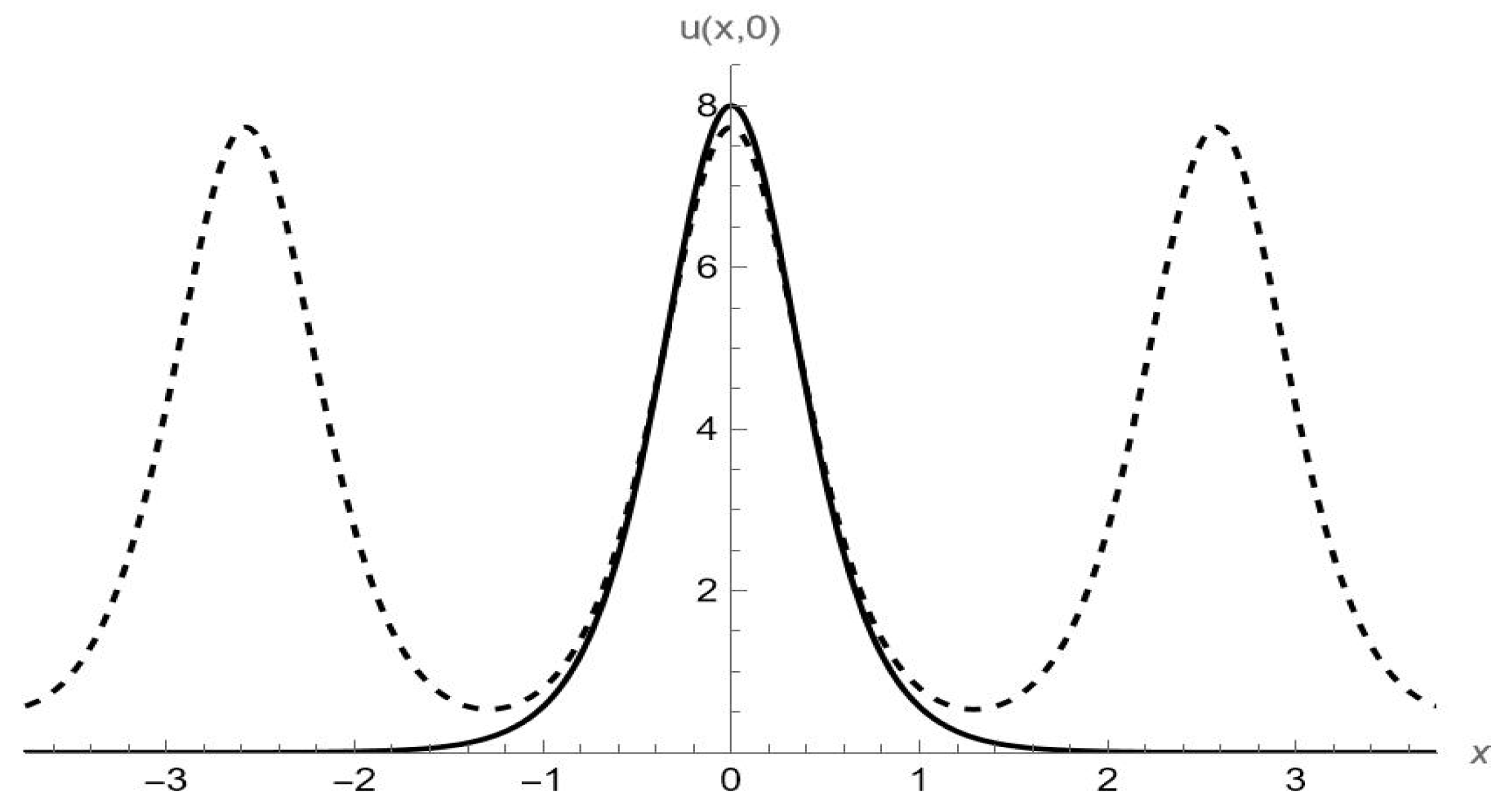
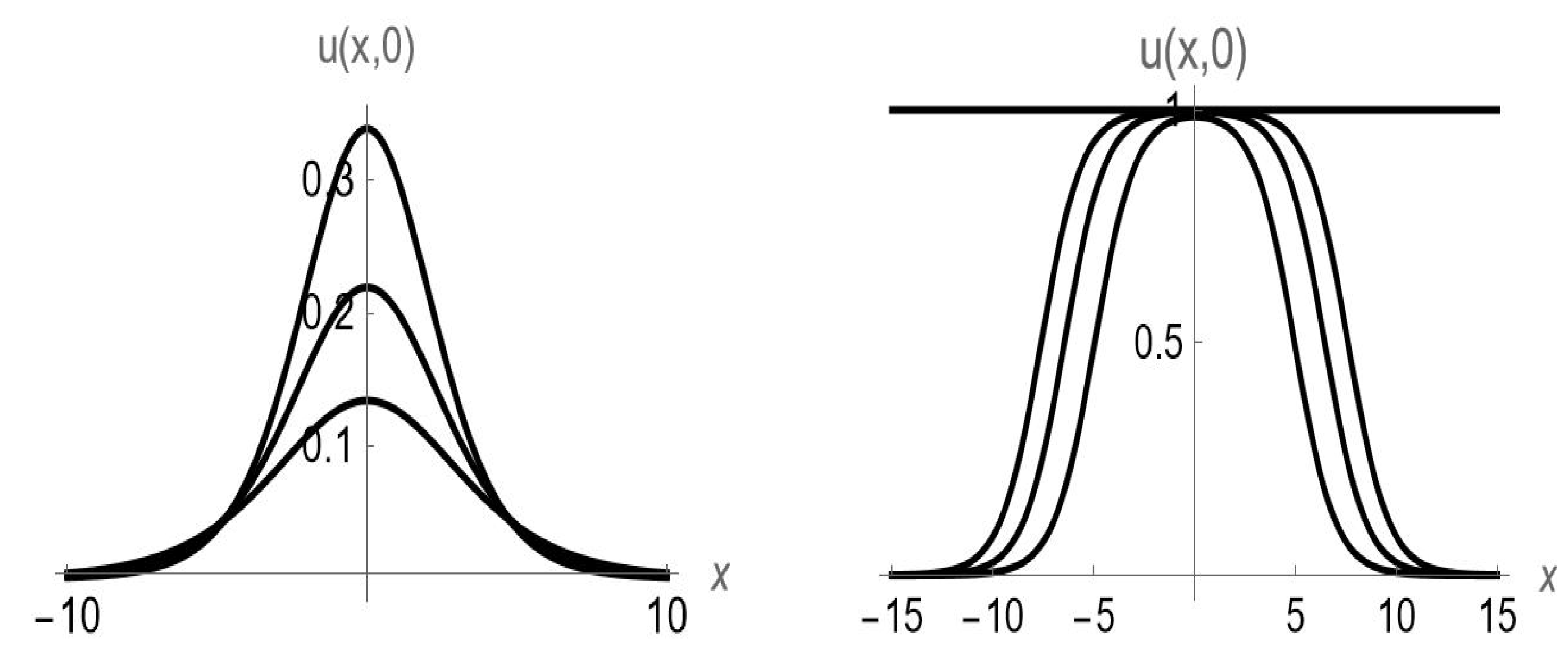
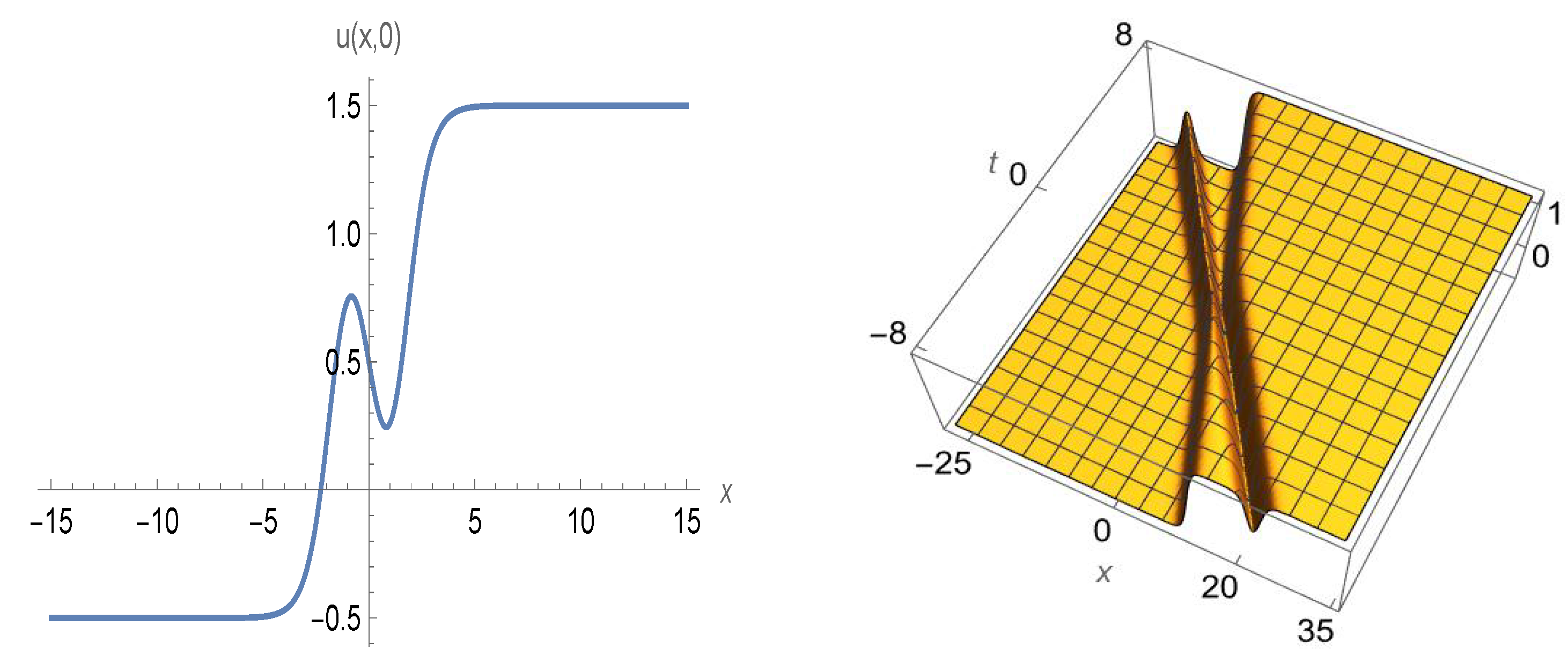
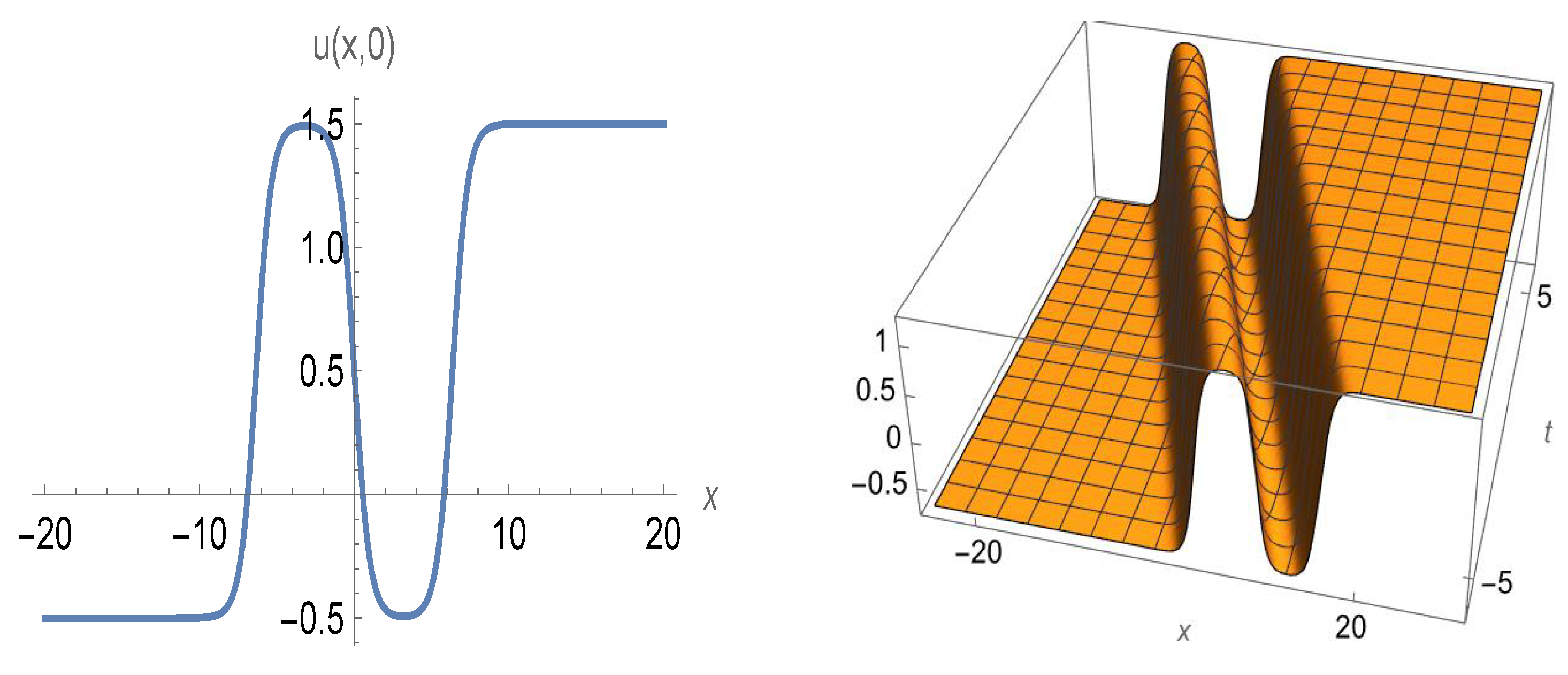
Disclaimer/Publisher’s Note: The statements, opinions and data contained in all publications are solely those of the individual author(s) and contributor(s) and not of MDPI and/or the editor(s). MDPI and/or the editor(s) disclaim responsibility for any injury to people or property resulting from any ideas, methods, instructions or products referred to in the content. |
© 2024 by the authors. Licensee MDPI, Basel, Switzerland. This article is an open access article distributed under the terms and conditions of the Creative Commons Attribution (CC BY) license (https://creativecommons.org/licenses/by/4.0/).
Share and Cite
Hereman, W.; Göktaş, Ü. Using Symmetries to Investigate the Complete Integrability, Solitary Wave Solutions and Solitons of the Gardner Equation. Math. Comput. Appl. 2024, 29, 91. https://doi.org/10.3390/mca29050091
Hereman W, Göktaş Ü. Using Symmetries to Investigate the Complete Integrability, Solitary Wave Solutions and Solitons of the Gardner Equation. Mathematical and Computational Applications. 2024; 29(5):91. https://doi.org/10.3390/mca29050091
Chicago/Turabian StyleHereman, Willy, and Ünal Göktaş. 2024. "Using Symmetries to Investigate the Complete Integrability, Solitary Wave Solutions and Solitons of the Gardner Equation" Mathematical and Computational Applications 29, no. 5: 91. https://doi.org/10.3390/mca29050091
APA StyleHereman, W., & Göktaş, Ü. (2024). Using Symmetries to Investigate the Complete Integrability, Solitary Wave Solutions and Solitons of the Gardner Equation. Mathematical and Computational Applications, 29(5), 91. https://doi.org/10.3390/mca29050091






